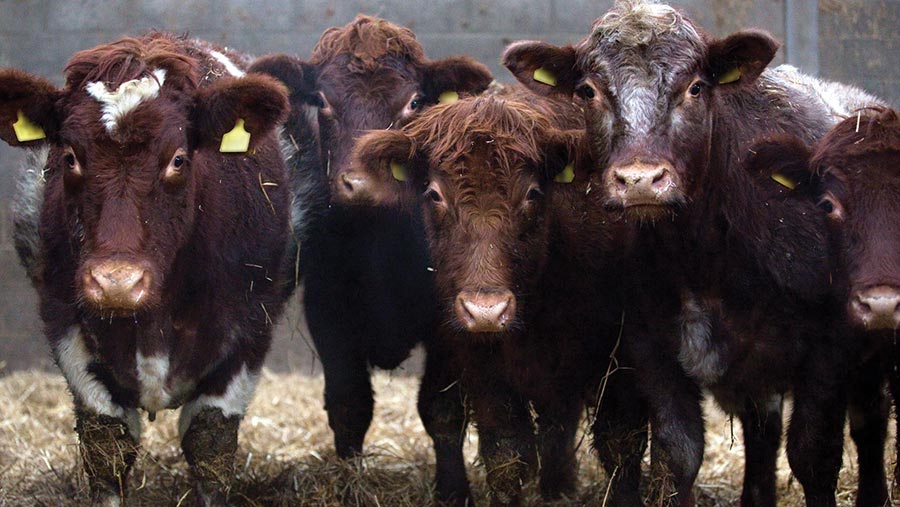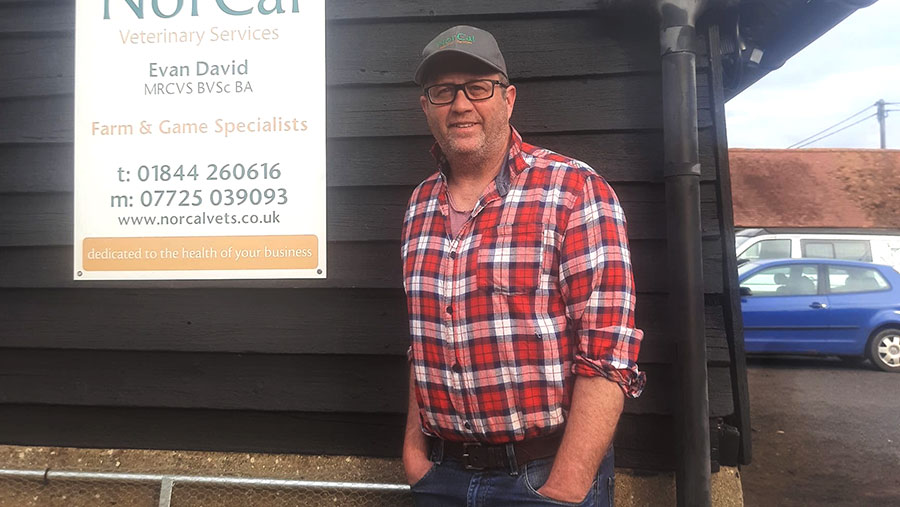Tips to protect cattle health from first housing to finishing
 © Tim Scrivener
© Tim Scrivener Huge effort is focused on getting calves off to the right start, with protocols for just about everything in the first few weeks and months of life. But all of that becomes redundant if the attention to animal health fades as the calf gets older.
Evan David of NorCal Veterinary Services in Oxfordshire shares some of the main pitfalls he and his team encounter from first housing through to finishing, and how best to avoid them.
First housing season
Weaning stress
Mr David’s practice typically sees two periods of pneumonia. Around February-March, there is often a spate of cases.
“Calves are becoming bigger, they’re eating more, producing more heat, they’ve got a big thick coat and we see bedding has built up over the housing season,” he says.
See also: How to manage common suckler calf health challenges
However, the first period is usually earlier, quite soon after housing. Pneumonia at this stage is often down to stress and big variations in temperature, swinging from very cold to quite mild. To combat this, he advises farmers to minimise the number of changes introduced at this time.
“The worst thing you can do is take a cow and calf out of the field and then stick them straight in the shed and separate them. It’s just too much stress for them all at once,” he says.
Top tips
- Soft-wean calves and dams for 10 days or more to let calves get used to being housed and a change of diet, before they are separated
- Use this soft-weaning window for any handling and vaccinations
- Explore different methods of soft weaning with tactical fencing/gates to offer different diets to cows and calves
- Introduce changes in diet slowly and increase protein and starch gradually to avoid any stress on the digestive system
Pneumonia pathogens
It is important to know your bugs, says Mr David, so the particular bacteria and viruses present on the farm can be targeted through vaccination in future years.
“If you’re a farm that buys a lot of cattle in, you don’t know what you’re going to get year to year, but if you’re a closed herd, then it is good to know what is going on.”
Top tips
- Keep on top of mucking out to avoid environmental buildup of pathogens
- Look out for store cattle running a high temperature with clear mucus from their nose, and get a swab tested before infection takes hold. Speak to your vet about this – it is sometimes possible to obtain a sample yourself with a cotton bud to avoid call-out charges.
- Ask your vet about the possibility of blood sampling. This can sometimes be subsidised by drug companies; if not, it will cost roughly £30 a head and involve testing about five to six animals from each management group

Evan David © NorCal Veterinary Services
Second grazing season
Clostridial diseases
This is the biggest single issue Mr David’s team sees in the second grazing season of a beef animal.
“These are the animals that you go out and shepherd and everything looks fine, and then all of a sudden one is dead,” he says.
This group of diseases, the most common being blackleg, is typically seen in calves from six months of age onwards and is caused by soil-borne bacteria when cattle are out at pasture.
Top tips
- Vaccinate against clostridial diseases before turnout. Cost is about £1/dose, with two doses required before turnout
- Beware of spreading muck on pasture, or leaving accessible muck heaps in a grazing field. Manure is likely to harbour the disease-causing bacteria.
Lungworm
Lungworm prevalence is strongly affected by weather, with dry summers and cold winters killing off the parasite larvae.
NorCal vets saw many cases last year during a consistently wet August and September, but they have not seen any cases so far this year because of the heat.
However, if young cattle are coughing at grass, they should be investigated for lungworm. This can be diagnosed through faecal samples.
Top tips
- Consider vaccination
- Keep stocking density as low as is feasible because higher stocking rates will increase risk
- Group animals of a similar age together
- Watch out for a red colouring on the grass in September/October – it is a fungus that can disperse lungworm larvae and cause massive outbreaks
See also: Advice on vaccinating cattle against lungworm: the do’s and don’ts
Fog fever
Fog fever is a severe type of pneumonia.
“We usually get it when animals aged 14-15 months old, or even cows, go from really bare pasture onto some very lush grass, often silage ground. They consume way too much, which causes a reaction in the rumen that leads to pneumonia,” explains Mr David.
Treatment is not often successful, so prevention is key.
Top tips
- Be cautious before moving cattle onto much stronger grass. If you are concerned, send your vet pictures of the pasture they are on currently, and the one you intend moving them to, and they might be able to advise over the phone
- Feed cattle hay before you move them so they have a full stomach and do not over-eat
- Strip-graze to restrict access to the new grass
Worms
These usually become a problem when stock is grazed too late in the year and the worm burden on the ground builds up.
“Long-term wormers work at the moment, but we are trying to get away from using one drug all the time because of the anthelmintic resistance risk,” Mr David explains.
Top tips
- Use the right wormers for your stock – this can be decided with veterinary advice and informed by faecal egg counts
- Rotationally graze to decrease worm burden on pasture
- Consider following cattle with sheep – although this can have its own risks, so caution is needed
Finishing
In a multisource finishing system, Mr David advocates an all-in, all-out system to reduce the risk of disease, especially respiratory disease.
He recommends fattening a group of cattle of similar size, so they finish at a similar time and the shed can be thoroughly cleaned before restocking.
“And if you’re buying in from multiple sources, you definitely need to vaccinate for pneumonia.”
See also: Finishing cattle: A guide to health planning and quarantine
Acidosis and pneumonia
One of the most common problems, frequently seen about 10 days after cattle have moved to a finishing diet, is a pneumonia which is not caused by an environmental pathogen, but a “gut upset”.
When finishers take store cattle straight from grass, if the transition to the starch-heavy finishing ration is too fast, it can cause the pH of the rumen to drop and leak bacteria.
The bacteria can cause liver abscesses and, through blood flow, result in lung abscesses.
“If you’re seeing liver abscesses on kill sheets, it is a suggestion that the transition in diet is not right,” Mr David says.
Top tip
- Introduce the change in diet over 10 days, building the carbohydrates up gradually during that time and maintaining plenty of fibre in the form of grass silage or straw
